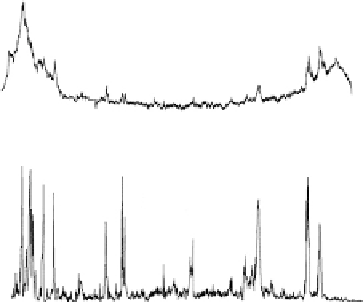Geoscience Reference
In-Depth Information
Sondrestrom Greenland
23 January 1985
Altitude (km)
300
400
498
400
300
2.0
Plasma density
1.6
1.2
0.8
0.4
0
15
12
9
6
3
0
e
2
Flux (10 eV-2keV)
100
200
300
400
500
600
Flight time (seconds)
Figure 10.9
Local plasma density along a rocket trajectory in the dayside auroral oval
along with precipitating electron fluxes. [After LaBelle et al. (1989). Reproduced with
permission of the American Geophysical Union.]
by LaBelle et al. (1989) assuming a steady electron flux for about 2 minutes.
Auroral arcs are very dynamic but this time scale is not at all unreasonable in the
cusp, and we conclude that structured soft electron input can create a very irreg-
ular F-layer plasma in the dayside auroral oval. Conversely, the hard spectrum
studied by Roble and Rees (1977), which is typical in the heart of the nighttime
auroral oval, had a production rate of only 100 cm
−
3
s
−
1
at 400 km even for a
total energy input of 8 ergs/cm
2
s.
The poleward edge of the nighttime auroral oval, on the other hand, is also
characterized by intense soft electron fluxes (Tanskanen et al., 1981) that are
capable of producing F-region plasma enhancements. This source may be related
to the numerous examples of plasma blobs in the nighttime oval detected by the
Chatanika radar which are similar to the one shown in Fig. 10.10a. A spectral
analysis of this particular radar map was performed by sampling the data with
a horizontal cut through the data set at 350 km altitude. The power spectrum
is given in Fig. 10.10b and is nearly identical to the rocket power spectrum
shown in Fig. 10.8, which was obtained in the cusp region. These plasma blobs
convect into and through the radar beam over a wide range of local times. Such
enhancements could have been created at the poleward edge of the auroral oval
and then convected into the field of view. They are much more common in the
Alaskan sector at solar maximum, which may be due to the larger scale height
of the neutral atmosphere and the corresponding increase in F-region plasma
production when soft particles precipitate (J. Vickrey, personal communication,
1982).
·


Search WWH ::

Custom Search